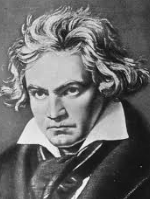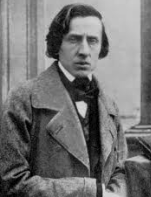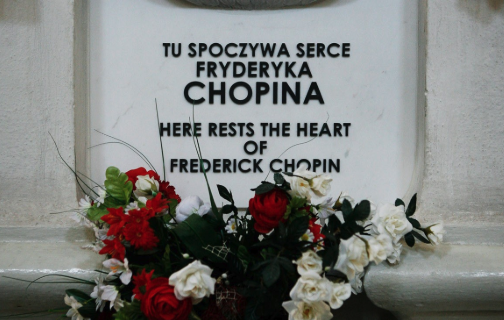When it comes to piano concertos I’m a bit of a traditionalist. I prefer the early 19th and late 18th century pieces to their 20th century descendants. I suspect it’s because of the lyricism of the great European composers of that era, and – to be blunt- the whistle-along tunes they composed. If you ask me, a lot of 20th Century pieces involve too much noodling; great if you’re a musical theorist who understands what’s going on but not always so great to listen to for lay people like me. But hey, that’s just my opinion and what do I know?

There are 2 stand out concertos that I keep going back to. Both are popular and well known which is a slight departure in terms of the music I’ve been writing about on this blog.
Firstly, Beethoven’s wonderful Piano Concerto No 5, known as the Emperor concerto; a name given to it by the English publisher of the piece. And then there’s the boringly named Piano Concerto No. 1 by Chopin.
Diageo. Adagio. Diego. It’s one of those.
The 2 pieces are linked by the year 1810, the year Chopin was born, and the year Beethoven composed the Emperor. The two are also linked by the genius of their slow, middle movements. Beethoven’s is an Adagio, or a piece that’s meant to be played slowly and leisurely. Chopin’s is strictly speaking a Larghetto, which means a piece that’s played slightly faster than largo but slower than adagio. Very illuminating.

Beethoven composed his wonderful Piano Concerto No 5 (in E flat for those who care about the technical stuff) when he was 40, in 1810, the year that Chopin was born. He was an accomplished piano player and violinist. His struggles with progressive hearing loss are well documented, but I didn’t know until I started researching this post that the last piece he played in concert was the Emperor. The performance didn’t go well as he was by then partially deaf and suffering from tinnitus to boot.
He Could Really Tickle The Ivories.
Chopin was a virtuoso painist who expanded the range of the instrument and pushed the limits of playing technique. I read one comment that modern piano technique begins with Chopin’s innovations. Unlike Beethoven, all of Chopin’s works incorporate the piano. He died at the tender age of 39. Rather bizarrely, on his death his heart was removed by the attending doctor, apparently at Chopin’s request, pickled in cognac and taken back to Poland in 1850 by his sister where it resides today, bricked up in a small shrine in Warsaw’s Holy Cross Church.

Anyway, to the music…
Both pieces are technically unforgiving and immensely difficult to play requiring the highest level of musicianship.
In the Emperor concerto, the incredibly romantic Adagio is sandwiched between 2 longer movements of immense power and energy; it’s a small oasis of peace and calm before the riotous 3rd movement, the Rondo.
The Adagio has claimed a place in 20th Century culture. In 1957, Leonard Bernstein wrote the music for one of the most popular musicals of the last 60 years, West Side Story. In a pivotal scene, just after Tony has stabbed Bernado to death, Tony and Maria sing the duet “Somewhere”.
Bernstein Stole It.
Have a listen to the song, and pay attention to the line “there’s a place for us” 30 seconds in to the movie clip here, sung rather croakily by Tony. Bernstein lifted the phrase directly from Beethoven’s piece, perhaps tipping his hat to the romanticism of the original piece. You can hear it at 3 mins 16 secs in to this recording where it appears as the part of the main melodic theme which starts at about 2 mins 58 seconds. Ignore the pianists facial expressions, which are a bit er.. distracting at times. Here’s a different link:
In Chopin’s concerto, the Larghetto -played in the linked video by Matha Argerich- is finally allowed to come up for air after the long, 20 minute opening movement. It’s a series of variations on the delightful opening melody that become increasing complex with each iteration, obviously showing off Chopin’s mastery of tickling the ivories. Remarkably he was only 20 when he wrote the work, the same age as my eldest son who’s still playing video games on line.
Anything You Can Do.
The Larghetto has also been used in films, although admittedly not ones as popular as West Side Story which won 10 (yes 10!) academy awards. The Lady In The Van, released in 2015 is a low budget British comedy set in Camden Town in London, written by the well known British playwright, Alan Bennett. Wikipedia explains it better than I could:
The Lady in the Van tells the true story of Alan Bennett‘s somewhat strained friendship with Miss Mary Shepherd, a crabby, eccentric and unsanitary homeless woman whom Bennett befriended in the 1970s before allowing her to park her Bedford van in the driveway of his Camden home “for three months”. She (lived) there for 15 years. Bennett learns Miss Shepherd’s true identity: Margaret Fairchild, a gifted former pupil of the pianist Alfred Cortot. She had played Chopin at The Proms, attempted to become a nun, was committed to an institution by her brother, escaped, had an accident when her van was hit by a motorcyclist for whose death she believed herself to blame, and thereafter lived in fear of arrest.
Source: https://en.wikipedia.org/wiki/The_Lady_in_the_Van
The scenes looking back at Miss Shepherd’s past as a concert pianist use Chopin’s Adagio repeatedly, and it was after watching the film that I went back and listened to it over and over, falling in love with it again after too many years of neglect.
And The Prize Goes To..
So the $6-million question is which do I prefer? Well, that’s a difficult one to answer but I think Chopin takes it for me. I think it’s the way he’s played with the main theme – teasing it into more and more complex and poetic forms. In contrast, Beethoven has left his alone and allowed the simplicity of the theme to carry it with little development.
If you listen to the full recordings of the 2 concertos stick around for the final movements. Crank up the volume and break out your inner air-conductor, jump up and down and wave your arms around. You won’t be disappointed. I’ve also posted them here.
Enjoy*.
*A Quick PS
I started this post on the weekend. I was already feeling slightly pensive tapping away at my keyboard, as I knew that my beautiful, warm-hearted dog, Toffee, was heading to the vet on Monday to investigate some breathing issues. Turns out I was right to be concerned because she has an inoperable cancerous tumour in her left nostril.

So my mood this afternoon has been one of real sadness; sadness that a well-loved member of our family is facing a major challenge.
Lo and behold, about half an hour after getting the diagnosis, Chopin’s piece got into my brain and turned into a full-on ear worm; its romanticism is (strangely) the perfect sound track to the hollow feeling that’s come over me on Monday. Anyone who’s owned a dog understands how close they become.
Don’t Forget
Dogs aren’t just for Christmas. They’re unquestioning, loving members of your family. Ours has been a wonderful companion. Please subscribe via the subscription box at the top of the page.

